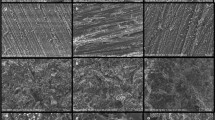Abstract
Aim:
The aim of this study was to investigate the corrosion resistance of orthodontic pliers from several manufacturers following different sterilization procedures, namely heat sterilization and the use of a disinfectant agent (Sekusept Extra N®) in an ultrasonic bath.
Material and Methods:
Employed in this study were ten distal-end cutters and ten Weingart pliers manufactured by Aesculap®, ETM and Hu-Friedy®, examined under electron microscopy for evidence of corrosion following 500 sterilization cycles. The corrosion data were recorded photographically and graphically. Metallographic microsections were prepared from each pair of pliers and were then analyzed by means of EDX measurements to assess the chemical alloy composition.
Results:
The light and electron microscopic evaluation showed that both heat sterilization and high level disinfection caused corrosive changes on the pliers. However, the type of corrosion differed between the two sterilization methods. The main type of corrosion with Sekusept Extra N® was pitting, while with heat sterilization it was surface corrosion. Heat sterilization was the type of corrosion that caused the most corrosive changes, regardless of which type of corrosion was considered. However, these results must be viewed critically, because pitting corrosion is obviously a more severe problem than surface corrosion.
In comparing the pliers of various manufacturers, differences were noted. However, it was difficult to rank them when the correct maintenance regime was adhered to.
The soldered joint gap was revealed to be a specific weak point, and that area proved to be inadequate due to qualities related to their production, particularly in the Hu-Friedy® pliers.
Conclusions:
This study showed that heat sterilization leads to less corrosion than cold disinfection. Corroded pliers can be restored to a useable condition by re-polishing, though it is important that the instructions for their care be strictly adhered to.
Zusammenfassung
Ziel:
Das Ziel dieser Studie war es, kieferorthopädische Zangen verschiedener Hersteller auf ihre Korrosionsbeständigkeit nach mehreren Sterilisationsdurchgängen mit Hitzesterilisation und einem Desinfektionsmittel (Sekusept Extra N®) im Ultraschallbad zu vergleichen.
Material und Methoden:
Bei der Studie wurden zehn Distalendcutter und zehn Weingartzangen der Firmen Aesculap®, ETM und Hu-Friedy® nach 500 Sterilisationsdurchgängen sowohl lichtmikroskopisch als auch rasterelektronenmikroskopisch auf Korrosionserscheinungen untersucht. Die Korrosionserscheinungen wurden dabei sowohl fotografisch als auch statistisch in einem dafür angefertigten Auswertungsbogen festgehalten. Zudem wurden Schliffe der Zangen hergestellt, über die mit der EDX-Analyse die Legierung der jeweiligen Zangen ermittelt werden konnte.
Ergebnisse:
Bei den licht- und rasterelektronischen Untersuchungen ergaben sich sowohl nach der Behandlung mit Hitzesterilisation als auch mit der High-level-Desinfektion korrosive Veränderungen an den Zangen. Es stellte sich heraus, dass Lochfraß die Hauptkorrosionsart bei der Behandlung der Zangen mit dem chemischen Desinfektionsmittel Sekusept Extra N® war, während durch Hitzesterilisation hauptsächlich Flächenkorrosion verursacht wurde. Die Hitzesterilisation war das Sterilisationsverfahren, bei welchem unabhängig von der Korrosionsart mehr Korrosionsveränderungen auftraten. Dies muss jedoch kritisch betrachtet werden, da es sich bei Lochfraß um die eindeutig schwerwiegendere Korrosionsform handelt.
Wenn man die Hersteller miteinander vergleicht, so schnitten die Zangen unterschiedlich ab. Eine Rangfolge war schwierig aufzustellen, wenn der Anwender sich korrekt an die Pflegehinweise hielt.
Der Lötspalt kristallisierte sich als besonderer Schwachpunkt heraus. Herstellungsbedingt waren dort, vor allem bei den Zangen von Hu-Friedy®, insuffiziente Bereiche auszumachen.
Schlussfolgerungen:
Die Studie zeigt, dass die Hitzesterilisation weniger Korrosionsschäden verursacht als die Kaltdesinfektion. Korrodierte Zangen können durch Politur wieder nutzbar gemacht werden. Es empfiehlt sich jedoch, die Pflegehinweise genau zu beachten.
Similar content being viewed by others
Author information
Authors and Affiliations
Corresponding author
Additional information
English version revised by Carol Cürten, Freiburg/Br.
Rights and permissions
About this article
Cite this article
Wichelhaus, A., Brauchle, G., Mertmann, M. et al. Corrosion of Orthodontic Pliers Using Different Sterilization Procedures. J Orofac Orthop 65, 501–511 (2004). https://doi.org/10.1007/s00056-004-0417-9
Received:
Accepted:
Issue Date:
DOI: https://doi.org/10.1007/s00056-004-0417-9




